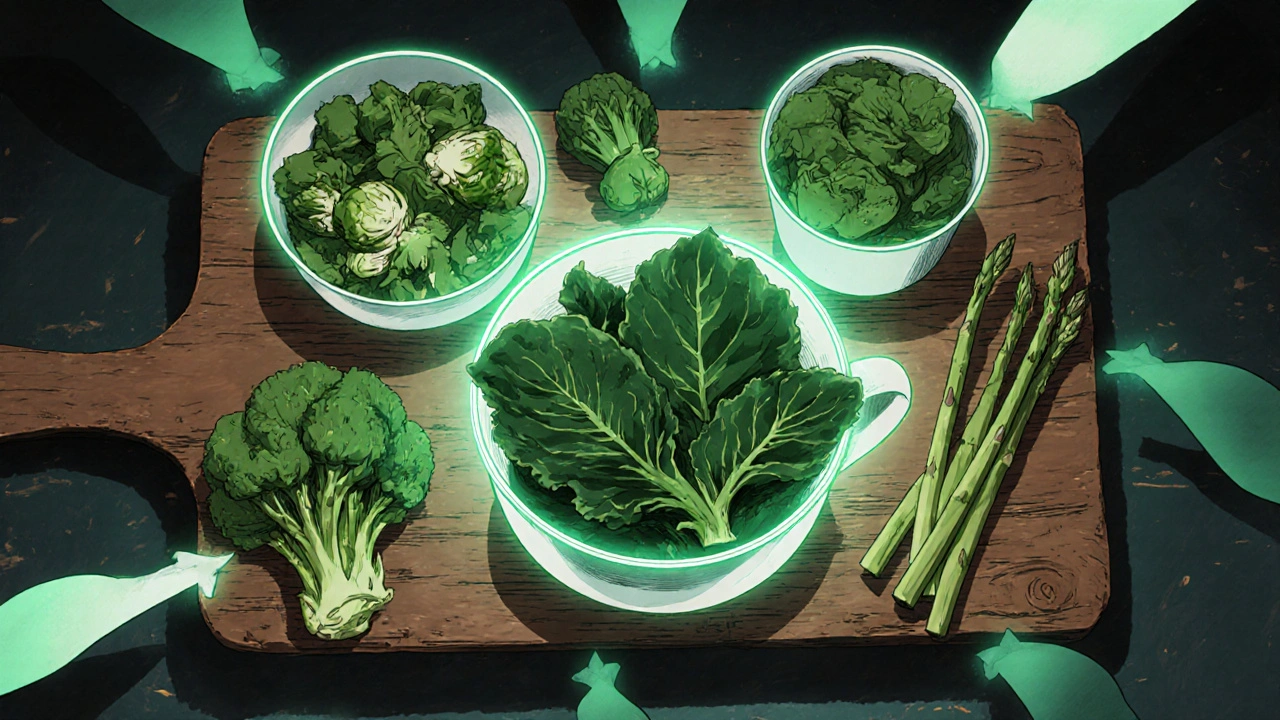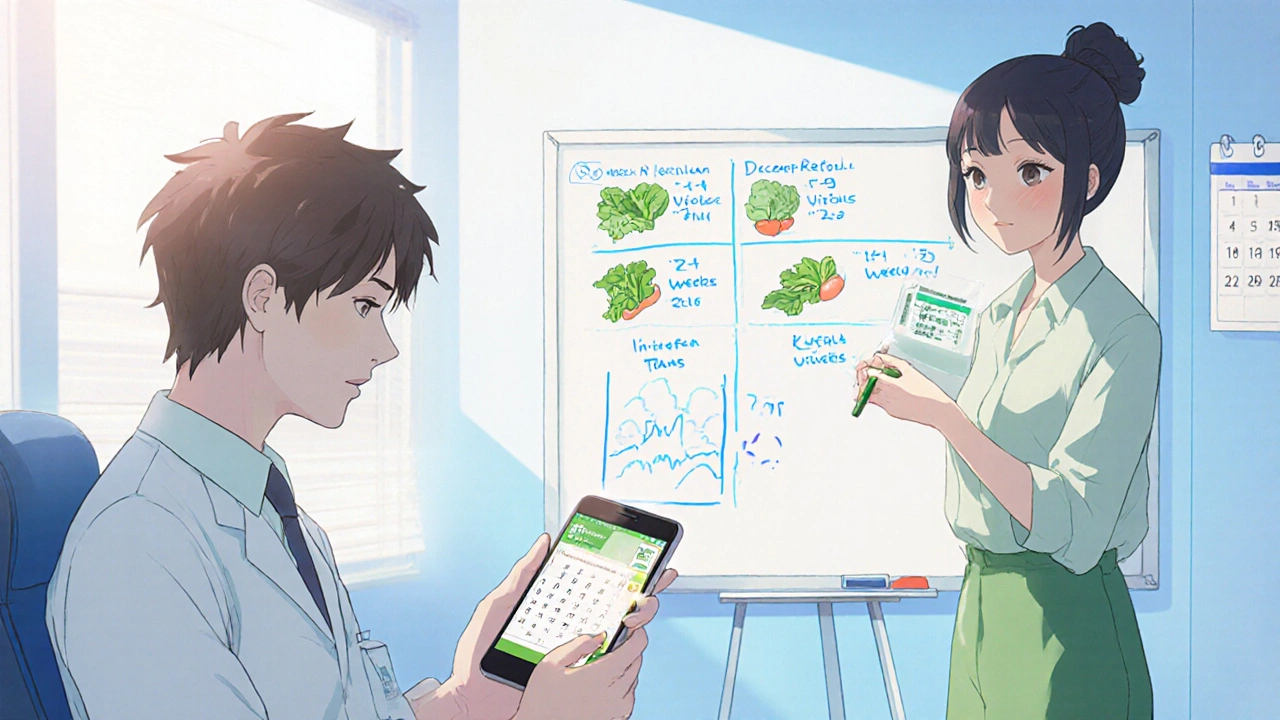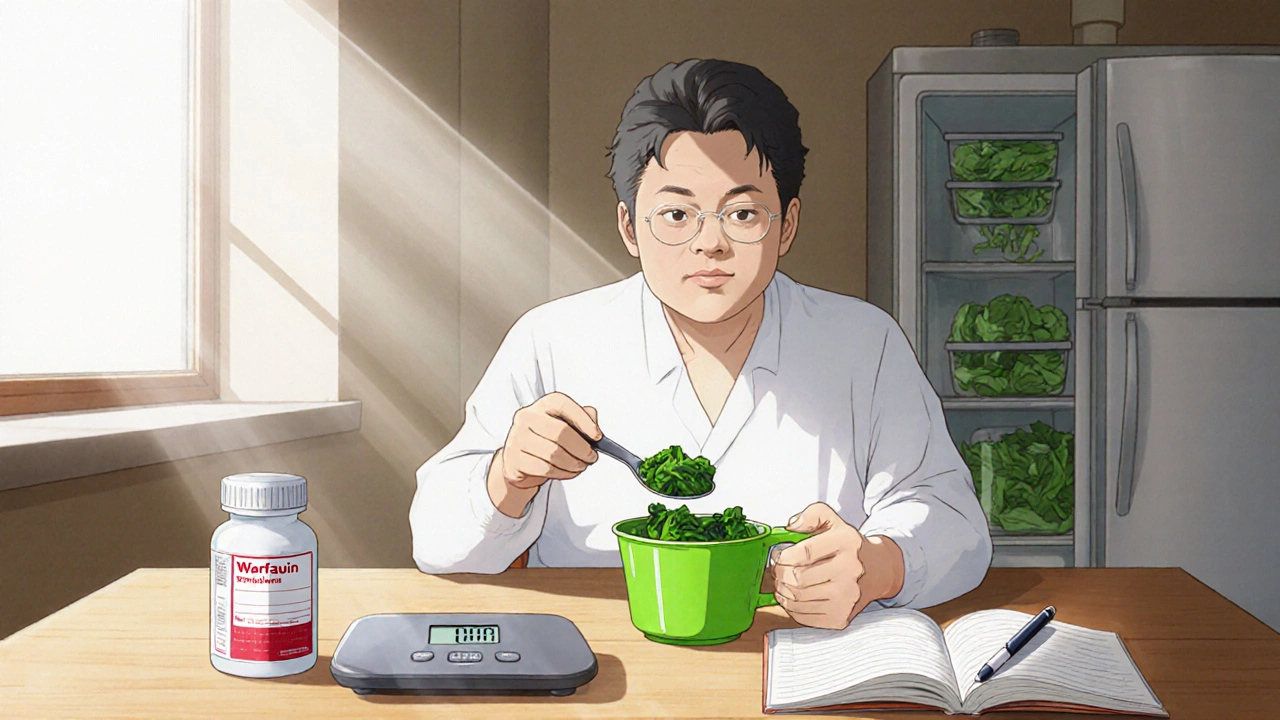Vitamin K Intake Tracker
Daily Vitamin K Tracker
Keep your vitamin K intake within 20% of your baseline to maintain stable INR levels.
Add Vitamin K Food
Your Intake Log
Key Takeaways
- Warfarin’s effect is directly linked to how much vitamin K you eat each day.
- Staying within a 20% range of your usual vitamin K intake keeps your INR in the therapeutic window 78% of the time.
- Track portions of leafy greens, use a food diary, and talk to a dietitian before making big changes.
- One unusually high‑vitamin K meal may require a temporary 10‑20% dose tweak, but only under medical supervision.
- Regular INR testing (every 2‑4 weeks when stable) lets you spot trends before a problem escalates.
Understanding the Warfarin-Vitamin K Relationship
Warfarin is a vitamin K antagonist anticoagulant that blocks the enzyme VKORC1 (Vitamin K Epoxide Reductase Complex subunit 1). By inhibiting VKORC1, warfarin prevents the recycling of vitamin K to its active form (KH2), which is required for the gamma‑carboxylation of clotting factors II, VII, IX, and X. Without this step, blood clots form more slowly, keeping patients at lower risk of thrombosis.
Because warfarin works by counteracting vitamin K, the amount of vitamin K you consume each day can swing your International Normalized Ratio (INR) up or down. A 100 µg rise in daily vitamin K can shave 0.5-1.0 points off a stable INR, according to UpToDate (2023). That’s why clinicians stress consistency over strict avoidance.
Why Consistency Beats Restriction
Early guidelines urged patients to avoid green veggies altogether. Modern consensus from the American Heart Association (2022) and the European Society of Cardiology (2020) now says: eat the same amount of vitamin K every day. Studies show patients who keep their vitamin K intake within a 20% window maintain therapeutic INR roughly 78% of the time, compared with just 42% for those who swing wildly between low‑ and high‑vitamin K days.
Consistency gives the liver a predictable amount of substrate to work with, so warfarin dosing stays steady. It also avoids the frustration of “diet poisoning” where a single salad knocks your INR out of range and forces an emergency dose tweak.

Vitamin K‑Rich Foods and Typical Portions
The bulk of dietary vitamin K comes from phylloquinone (vitamin K1) found in leafy greens. Below is a quick reference for common foods and the amount of vitamin K they deliver per typical serving.
| Food | Serving size | Vitamin K (µg) |
|---|---|---|
| Kale (cooked) | 1 cup | 1,062 |
| Spinach (cooked) | 1 cup | 889 |
| Swiss chard (raw) | 1 cup | 299 |
| Broccoli (raw) | 1 cup | 85 |
| Brussels sprouts (cooked) | 1 cup | 156 |
| Asparagus (cooked) | 1 cup | 70 |
Notice how a single cup of kale or spinach dwarfs the vitamin K you’d get from a typical Western diet (≈120 µg for men, 90 µg for women). That’s why a “kale cleanse” can knock the INR down dramatically.
Practical Strategies for Consistent Vitamin K Intake
- Pick a baseline amount. Decide on a realistic daily serving of leafy greens-say, two cups of cooked spinach three times a week and one cup of kale on the other days.
- Measure, don’t guess. Use a kitchen measuring cup or a digital scale. Estimating a handful of kale can vary by 30‑40%.
- Keep a food diary. Log every vitamin K‑rich item. A simple food diary (paper or app) helps you spot patterns before the next INR draw.
- Standardize multivitamins. If you take a supplement, choose one with a fixed vitamin K content and stick with it.
- Plan restaurant meals. Call ahead and ask for the amount of greens in a dish. When in doubt, order the same meal you’d have at home.
- Partner with a dietitian. A registered dietitian experienced in anticoagulation can build a personalized menu and adjust portions as your health changes.
These steps turn a vague “eat more veggies” goal into a measurable habit that won’t shock your INR.

Handling an Unexpected High‑Vitamin K Meal
If you accidentally double your usual intake-say, a big kale Caesar salad-don’t panic. Follow these guidelines:
- Contact your anticoagulation clinic or provider within 24 hours.
- Under medical supervision, the warfarin dose may be increased by 10‑20% for the next day, then re‑evaluated at the next INR test.
- In rare cases where INR falls below 2.0, a short‑term low‑dose vitamin K (1‑2.5 mg oral) can bring the INR back up safely.
Never adjust the dose on your own; even a modest increase can push the INR too high and raise bleeding risk.
Monitoring INR and Working with Your Healthcare Team
When your diet is stable, most clinicians check INR every 2‑4 weeks. If you’re making a diet change, expect weekly testing for the first 2‑3 weeks. Document the test dates, results, and any dietary notes in your food diary so the anticoagulation pharmacist can spot trends.
Many centers have dedicated Anticoagulation Clinics that offer phone‑in support, dose‑adjustment algorithms, and dietitian referrals. Take advantage of their expertise; patients who receive individualized counseling achieve therapeutic INR 85% of the time versus 65% with standard care.
Quick FAQ
Can I stop eating leafy greens altogether?
No. Removing vitamin K entirely can make warfarin too potent, raising bleeding risk. The goal is steady intake, not avoidance.
How much vitamin K should a warfarin patient aim for each day?
Most guidelines suggest a consistent range of 75‑100 µg per day, which aligns with the average adult AI and provides predictable INR control.
What if I travel and can’t get my usual veggies?
Aim for the closest match in portion size. If you end up eating 30% less vitamin K for a few days, schedule an INR test a few days later and let your provider know.
Is a multivitamin safe while on warfarin?
Only if it has a consistent, low vitamin K content. Check the label and discuss it with your pharmacist.
How quickly does a dose change affect INR?
Warfarin has a half‑life of 36‑42 hours, so a dose adjustment typically shows up in the next INR draw (2‑4 days later).
Sticking to a predictable warfarin diet doesn’t mean you can’t enjoy tasty meals; it just means you plan the amount of vitamin K you eat and keep track. With a food diary, a trusted dietitian, and regular INR checks, you’ll stay in the therapeutic window and lower the risk of clotting or bleeding.

Paul Luxford
October 26, 2025 AT 14:10I try to keep my kale portions consistent so my INR stays steady.
Manoj Kumar
October 27, 2025 AT 17:56If you ever wondered why your warfarin dose feels like a roller‑coaster, the answer is probably hiding in your salad bowl.
Consistency, not avoidance, is the golden rule, and that fact is as obvious as the fact that kale is green.
Your liver likes a predictable supply of vitamin K, otherwise it throws a tantrum and your INR does a nosedive.
Eating two cups of spinach one day and a mountain of kale the next is like telling your car to drive on gasoline one minute and then switching to diesel without warning.
The studies quoted in the guide are not some far‑off myth; they actually show a 78% success rate when people stay within a 20% window of their usual intake.
That 20% window is easy to miss if you’re counting by handfuls instead of by measured cups.
I’ve seen patients who measure their greens with a kitchen scale and end up with INR numbers that look like a well‑behaved spreadsheet.
On the other hand, those who guess a ‘handful’ of kale often end up in the emergency department, scrambling for a dose tweak.
The guide’s suggestion to call your clinic within 24 hours after a high‑vitamin K meal is not a suggestion, it’s a safety net.
Your warfarin is a delicate balance; a single extra cup of cooked kale can shave off half a point on your INR, which is enough to tip you from safe to risky.
And let’s not forget that vitamin K isn’t the only player – other foods, medications, and even your mood can jitter the numbers.
But if you keep your leafy green intake as steady as your morning coffee, you’ll give your provider a much easier job.
Think of your diet as a spreadsheet where each column is a day and the vitamin K value is a constant you never change.
When the numbers stay the same, your dose stays the same, and you stay out of the hospital.
So, grab your measuring cup, log those greens, and enjoy the peace of mind that comes with not having to call the anticoagulation clinic every other day.
Hershel Lilly
October 28, 2025 AT 21:43I’ve been tracking my spinach servings for a few months now, and the INR swings have really smoothed out.
It’s surprising how a half‑cup difference can make the numbers jump a full point.
Using a simple notebook on my phone has been a game‑changer – I just jot down “1 cup cooked spinach” and the time.
Laura Hibbard
October 30, 2025 AT 01:30Wow, that philosophical spin on greens really hits the nail on the head – if you think about it, warfarin is just a diet‑dependent math problem.
Keeping the math simple by measuring your kale means you won’t have to solve a new equation every week.
Rachel Zack
October 31, 2025 AT 05:16I cant beleve how many peple still trt to avoid vegtables completly.
Thats just not realistic and it makes the dose alittle more compicated.
Lori Brown
November 1, 2025 AT 09:03Hey, consistency isn’t about never having fun with food – it’s about knowing how much fun you’re having! 😊
Measure, log, and enjoy the peace of mind.
Jacqui Bryant
November 2, 2025 AT 12:50Simple tip: use the same spoon for measuring greens every time – it makes it easy and you won’t have to guess.
Brady Johnson
November 3, 2025 AT 16:36Let me guess, you think a little extra kale is harmless? That’s the kind of reckless optimism that lands people in the ER. I’ve watched patients think they’re clever, then watch their INR plummet like a stone. It’s not a joke; it’s a life‑or‑death balance. The guide tells you to call your clinic – you’d think that’s common sense. But what you really need is discipline, not excuses. Stop treating your medication like a game and start treating it like a responsibility. One stray salad can throw your whole week off, and you’ll be scrambling for a dose adjustment. The only way to avoid that is to stop being lazy about your diet. Consistency isn’t optional, it’s mandatory. If you can’t manage a cup of kale, maybe you’re not cut out for warfarin at all.
Jay Campbell
November 4, 2025 AT 20:23I hear you, but let’s keep it civil – the guide already stresses the importance of consistency, so a gentle reminder is enough.
Carla Smalls
November 6, 2025 AT 00:10Remember, you don’t have to give up all your favorite dishes – just make them predictable.
Talk to a dietitian to find a plan that fits your lifestyle.
Monika Pardon
November 7, 2025 AT 03:56Ah, the ever‑so‑trustworthy dietitian – a noble profession, provided they’re not secretly feeding us kale conspiracies.
In all seriousness, a tailored plan is the best defense against the dreaded INR roller‑coaster.
Rhea Lesandra
November 8, 2025 AT 07:43Let’s break this down step by step so anyone can follow along without feeling overwhelmed.
First, identify your typical daily intake of vitamin K‑rich foods – that’s your baseline.
Second, use a measuring cup or a kitchen scale to keep portions consistent; guessing leads to the wild swings we all try to avoid.
Third, log each meal in a simple notebook or phone app – the act of writing it down reinforces the habit.
Fourth, schedule INR checks every 2‑4 weeks when you’re stable, and more frequently after any dietary change.
Fifth, if you have a high‑vitamin K day, contact your clinic within 24 hours; they’ll guide you on temporary dose tweaks.
Sixth, keep a backup plan for travel or unexpected meals – know the approximate vitamin K content of restaurant dishes.
Seventh, stay in touch with a dietitian who understands anticoagulation; they can adjust your plan as your health evolves.
Finally, celebrate the small victories – a steady INR is a sign you’ve mastered the art of balance.
Dave Sykes
November 9, 2025 AT 11:30Great checklist – stick to it and you’ll keep your INR where it belongs.
Erin Leach
November 10, 2025 AT 15:16I totally get how easy it is to overlook a extra serving of greens; just remember a quick note in your phone can save a lot of hassle later.
Erik Redli
November 11, 2025 AT 19:03Honestly, all this “log your food” nonsense is just a way for the pharma industry to make us buy more apps. Who needs a notebook when you can just watch your INR swing and learn the hard way?